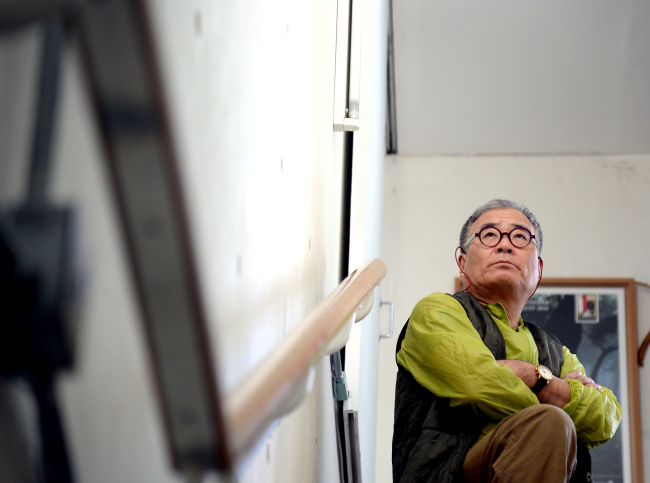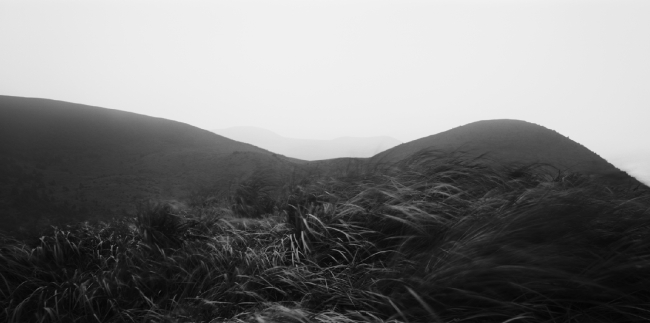
Photographer Bae Bien-u poses at his studio in Paju, Gyeonggi Province, earlier this month. (Ahn Hoon/The Korea Herald)
Sitting in front of a large table in the second-floor library of photographer Bae Bien-u’s studio in Hyeri, an artists’ village near the DMZ in Paju, Gyeonggi Province, Bae’s passions ― aside from the obvious, photography ― are apparent.
Several thousand books ― on topics ranging from art, photography and history to cookbooks, all arranged alphabetically by title ― fill the bookcases lining the walls, and the marble-top kitchen counter and the professional-grade stainless steel pots that sit atop the stove give away his twin passions of reading and cooking.
One of the most highly regarded local photographers today, Bae, 65, who studied design at Hongik University, is a largely self-taught photographer. He began taking photographs with a Nikon F in the 1970s, roaming the fields of Jeju-do Island and the shores of Yeosu, South Jeolla Province, his hometown on the south coast. “I had not studied (photography) abroad so I head to study on my own,” he says. Books that he began buying at the time form the backbone of his extensive library.
Today, he works with a Linhof, a metal chunk of a camera that weighs a hefty 5 kilograms and was custom-made in Munich, Germany. “It is a panorama camera with a 1:2 ratio,” he says.
The camera is an essential part of his works that have been likened to Eastern paintings by critics in the West. Abroad, where he was “discovered” first, Bae is seen as reinterpreting Asia’s ink-and-wash painting through photography. Indeed, there is a zen-like calm to his black-and-white works ― shiny black stones in a misty sea, tall wild grass bending with the wind against the backdrop of a gently rolling hill ― that translate nature in its raw form into a soothing experience. “In Western paintings, 1:1.3 is considered the golden ratio; 1:2 is more like Eastern ink-and-wash paintings,” Bae explains.
Ink-and-wash painting
Bae, who doesn’t crop his photographs, holds the camera horizontally for panorama shots and vertically for shots that resemble Eastern painting scrolls that are hung vertically. “Hanji (mulberry paper) is made in a 1:2 ratio and therefore Korean paintings are in 1:2 ratio,” Bae explains.
Bae’s works follow the tradition of landscape paintings in Korea, influenced by the Joseon-period artist Gyeomjae Jeong Seon, a prolific painter of Korea’s landscapes, for whom Bae holds the highest respect. Gyeomjae’s paintings almost always portray pine trees ― a subject matter for which Bae is best known ― and willow trees. “Gyeomjae tried to achieve a balance of yin and yang in his works by painting pine trees, which are considered male, and willow trees, considered female, in the same piece,” Bae explains, taking out a book on Gyeomjae from a bookshelf and pointing to his paintings in it.
“Pine trees are a symbol of Korea’s nature. It is in every aspect of our lives,” he says. His work with pine trees goes back to 1983 when he began shooting the Silla royal tombs in Gyeongju. The royal tombs were invariably surrounded by pine tree groves. Having shot numerous works around the Silla royal tombs, and later in Gyeongbok Palace, Changdeok Palace and Jongmyo shrine, Bae jokes, “The kings must be looking after me.”
Photography is hard labor. “Determining the best vantage point comes from industriousness,” Bae says. Only complete familiarity with a place allows one to decide on the best spot, and that familiarity comes from walking the unpaved, untrodden paths for miles and miles. “What you do in your 40s and 50s derives from the power you built up in your 20s,” Bae observes, pointing out the importance of hard work.
While Bae does go into shooting with concepts in mind, he acknowledges that the weather determines everything. “Lighting is something God does,” he says. Even Edward Steichen, widely known as the highest-paid photographer and a genius with lighting, in his later works turned to using one light. “That is emblemic of the sun, the one, single sun,” Bae says.
Preferring to work with morning light, Bae completes his shootings in the morning. He knows what time the sun rose each morning. “This morning, the sun rose at 7:20,” he says. “I may drink late into the night but come dawn, I wake up my assistant and we drive to Gangwon Province to shoot in the morning light,” Bae says.
“Photography is about understanding and handling light,” Bae writes in his 2010 book, referring to photographs as paintings done with light.
Photography is also lonely work. “Eighty percent of the time, I travel alone on photo assignments,” he says. As his traveling companions, he takes along five to 10 books, mostly history books.
While Bae works with Kodak films, he is not resistant to digital technology. “I will switch to digital when film is no longer produced,” Bae says. “In fact, film is less pretty. Digital yields colorful pictures,” he explains, flipping through pages of photos stored on his smartphone.
Has he ever regretted missing a shot?
“I carry a camera with me 99 percent of the time, but there are times when I don’t have it with me,” he says. “Every second is different, so by the time I fetch my camera a few meters away, things have changed.”
Worship of nature

OM 1A-050H, 1999. (Bae Bien-u)
While Bae is best known for photographs of pine trees, his personal favorites are those of the sea. A native of the port city of Yeosu, the sea is the subject with which Bae is most familiar. “I go to the sea to develop my ideas, and I love fish!” he says.
The color of the sea is determined by the seabed, far below the surface. “The waters off Hamdeok, U-do, Geumryeong and Woljeong are emerald because of the dead coral leaf,” Bae notes.
Asked about his favorite sea, he answers, “Those I went to with pretty women,” half in jest.
Like most Koreans, Bae spurned the muddy west coast. That was until 2012 when he embarked on a two-year project that brought him to the area that boasts 1,004 islands scattered like small gems. “Sinan is a new discovery,” Bae declares. “The west coast is beautiful. It is our prejudice that prevents us from seeing its beauty.”
Primarily a landscape photographer ― his photos of buildings, including those of Korean traditional architecture that are due out later this year from Samsung Foundation of Culture as part of a 10-volume series, have been commissioned works ― Bae is vocal about nature conservation. “I think nature is sublime. My works are in worship of nature,” he says.
Bae, who has worked extensively on Jeju-do Island since the 1970s capturing its waters, beaches and oreum, or secondary volcanoes, laments the state of Jeju today. “It is a mess,” he says of the island’s development. In his view, the once idyllic semi-tropical island is now overpopulated and has far too many roads. “There are 20-30 golf courses, mostly located mid-mountain,” says Bae. The pesticides and herbicides that are used on the golf courses contaminate the drinking water, according to Bae.
Explaining how he cannot help but be concerned about the environment since he works with nature, Bae turns to discussing preserving the country’s islands. Talking about Muui-do, a tiny island near Incheon void of cars today, Bae says he is against the plan to build roads there. Of Marado, an island 30 minutes south of Jejudo Island, Bae says, “It takes only 30 minutes to go around the island, yet there are cars!”
“The reason islands are beautiful is because they are densely forested and untouched by humans,” he notes, suggesting that Korea could take lessons from New Caledonia, a place he captured in his works a few years ago, which limits the number of visitors allowed on the islands and the hours they spend there.
Turning to his hometown of Yeosu, Bae slams shut a photography book sitting open on the table. “There are metal staircases, bridges. They are drilling holes on the stones,” he says with a look of great agitation.
Although he has traveled and shot around the world, North Korea is a country he has yet to photograph. “I visited Mt. Geumgangsan once. I was very impressed by the pine trees along the coastline.”
Bae wants to capture nature in North Korea. “I want to capture nature in its wild form. I want to shoot in Mt. Myohyangsan, and mountains around Hwanghae Province.”
For the more immediate future, he plans on working on the waters off Namhae on the south coast. “Once I have a clear concept, I will shoot from the west coast to the south coast,” Bae says.
“I think about building a garden and shooting there, when I get older,” says Bae ― much like the Impressionist Claude Monet, another master of light, who spent his last years painting in the garden he built in Giverny.
By Kim Hoo-ran (khooran@heraldcorp.com)





![[Grace Kao] Hybe vs. Ador: Inspiration, imitation and plagiarism](http://res.heraldm.com/phpwas/restmb_idxmake.php?idx=645&simg=/content/image/2024/04/28/20240428050220_0.jpg&u=)
![[Herald Interview] Mom’s Touch seeks to replicate success in Japan](http://res.heraldm.com/phpwas/restmb_idxmake.php?idx=645&simg=/content/image/2024/04/29/20240429050568_0.jpg&u=)
